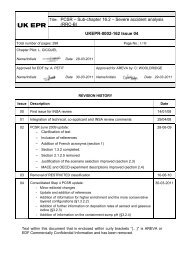14.7 - Fault and Protection Schedule - EDF Hinkley Point
14.7 - Fault and Protection Schedule - EDF Hinkley Point
14.7 - Fault and Protection Schedule - EDF Hinkley Point
You also want an ePaper? Increase the reach of your titles
YUMPU automatically turns print PDFs into web optimized ePapers that Google loves.
PRE-CONSTRUCTION SAFETY REPORT<br />
CHAPTER 14: DESIGN BASIS ANALYSIS<br />
SUB-CHAPTER : <strong>14.7</strong><br />
PAGE : 3 / 48<br />
Document ID.No.<br />
UKEPR-0002-149 Issue 02<br />
The main subsequent additions to the FRATEC 01 approach were linked to changes in “design<br />
rules” (e.g. SFC, i.e. redundancy requirement at the component level) shifting to “safety analysis<br />
rules” (e.g. the requirement to assume an “aggravating failure” i.e. a redundancy requirement at<br />
the function level). Other examples were extension of the scenario duration through the operator<br />
action phase, <strong>and</strong> the introduction of additional event combinations involving Loss Of Offsite<br />
Power (LOOP).<br />
Changes to the list of events were made related to the experience feedback <strong>and</strong> changes in<br />
system design options.<br />
EPR specific options led to transients being added or excluded from the Design Basis<br />
Assessment (DBA) list that was used for in service French Nuclear Power Plants (NPP). The<br />
changes were in three main categories as follows:<br />
1) Changes resulting from EPR constitutive options, such as:<br />
• consideration of transients occurring in the different plant states led to PCC events<br />
for outages being introduced as design basis accidents (these were considered as<br />
beyond design basis accidents in previous French NPPs, <strong>and</strong> consequently<br />
analysed using less stringent rules);<br />
• consideration of transients in auxiliary buildings, which led to the introduction of fuel<br />
pool transients, <strong>and</strong> transients in the effluent treatment building <strong>and</strong> the nuclear<br />
auxiliary building.<br />
2) Changes due to design improvements in the EPR that had a direct impact on the list of<br />
design basis faults. An example was application of the break preclusion principle that led to the<br />
exclusion of 2-A LOCA from the PCC list. LOCA outside the containment was added to the DBA<br />
list to address the specific EPR design of the residual heat removal system function, which is<br />
provided by the safety injection system.<br />
3) Changes due to the application of PSA early in the design process, which impacted on the<br />
justification of the list itself <strong>and</strong> on the way transients were arranged into the different PCC<br />
categories.<br />
The use of PSA also impacted the list of RRC-A events considered, as mentioned below.<br />
1.3. CORE-MELT RISK REDUCTION CATEGORY (RRC-A EVENTS)<br />
The origin of the list of scenarios involving multiple failures (called RRC-A sequences in the EPR<br />
approach) was a French Safety Authority (ASN) request for consideration of design extension<br />
conditions representative of the total loss of main redundant systems (power supply, heat sink,<br />
SG feedwater, long term RIS [SIS] <strong>and</strong> reactor trip through Anticipated Transients Without<br />
Scram). PCC-4 criteria were imposed, but less stringent rules were accepted.<br />
Later on, other scenarios were added at the request of the ASN, generally to illustrate the<br />
robustness of the defence in the EPR design (drainage of two SGs, initially corresponding to the<br />
SFC exception on main steam isolation valves; multiple SGTRs combined with Main Steam Line<br />
Break).














![6.3 - Safety Injection System (RIS [SIS]) - EDF Hinkley Point](https://img.yumpu.com/42739985/1/184x260/63-safety-injection-system-ris-sis-edf-hinkley-point.jpg?quality=85)


